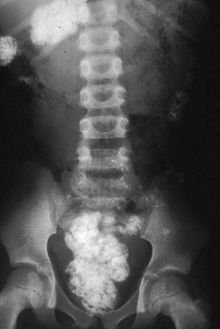
Back أكل التراب Arabic Геофагия Bulgarian Geofágie Czech Geofagi Danish Erdeessen German Γεωφαγία Greek Geofagia Spanish خاکخواری Persian Géophagie French Geofagia ID

Geophagia (/ˌdʒiːəˈfeɪdʒ(i)ə/), also known as geophagy (/dʒiˈɒfədʒi/),[1] is the intentional[2] practice of eating earth or soil-like substances such as clay, chalk, or termite mounds. It is a behavioural adaptation that occurs in many non-human animals and has been documented in more than 100 primate species.[3] Geophagy in non-human primates is primarily used for protection from parasites, to provide mineral supplements and to help metabolize toxic compounds from leaves.[4] Geophagy also occurs in humans and is most commonly reported among children and pregnant women.[5]
Human geophagia is a form of pica – the craving and purposive consumption of non-food items – and is classified as an eating disorder in the Diagnostic and Statistical Manual of Mental Disorders (DSM) if not socially or culturally appropriate.[6] Sometimes geophagy is a consequence of carrying a hookworm infection. Although its etiology remains unknown, geophagy has many potential adaptive health benefits as well as negative consequences.[5][7]
- ^ Ziegler, J. (1997). "Geophagia: a vestige of paleonutrition?". Tropical Medicine and International Health. 2 (7): 609–611. doi:10.1046/j.1365-3156.1997.d01-359.x. PMID 9270727. S2CID 71822543.
- ^ Fack, Vinciane; Shanee, Sam; Vercauteren Drubbel, Régine; Vercauteren, Martine; Meunier, Hélène (May 2020). "Geophagy in the yellow-tailed woolly monkey (Lagothrix flavicauda) at La Esperanza, Peru: site characterization and soil composition". Primates. 61 (3): 507–518. doi:10.1007/s10329-020-00802-9. PMID 32095910. S2CID 211253699.
- ^ Pebsworth, Paula A.; Huffman, Michael A.; Lambert, Joanna E.; Young, Sera L. (January 2019). "Geophagy among nonhuman primates: A systematic review of current knowledge and suggestions for future directions". American Journal of Physical Anthropology. 168 (S67): 164–194. doi:10.1002/ajpa.23724. PMID 30508222.
- ^ Cite error: The named reference
:02was invoked but never defined (see the help page). - ^ a b Young, Sera L. (2011). Craving earth : understanding pica : the urge to eat clay, starch, ice, and chalk (Pbk. ed.). New York: Columbia University Press. ISBN 9780231146081. OCLC 806349461.[page needed]
- ^ DSM-5 Task Force (2013). Diagnostic and statistical manual of mental disorders : DSM-5 (5th ed.). Arlington, VA: American Psychiatric Association. ISBN 978-0-89042-554-1. OCLC 830807378.
{{cite book}}: CS1 maint: numeric names: authors list (link) - ^ Young, Sera L.; Miller, Joshua D. (February 2019). "Medicine Beneath Your Feet: A Biocultural Examination of the Risks and Benefits of Geophagy". Clays and Clay Minerals. 67 (1): 81–90. Bibcode:2019CCM....67...81Y. doi:10.1007/s42860-018-0004-6. S2CID 132319907.
© MMXXIII Rich X Search. We shall prevail. All rights reserved. Rich X Search